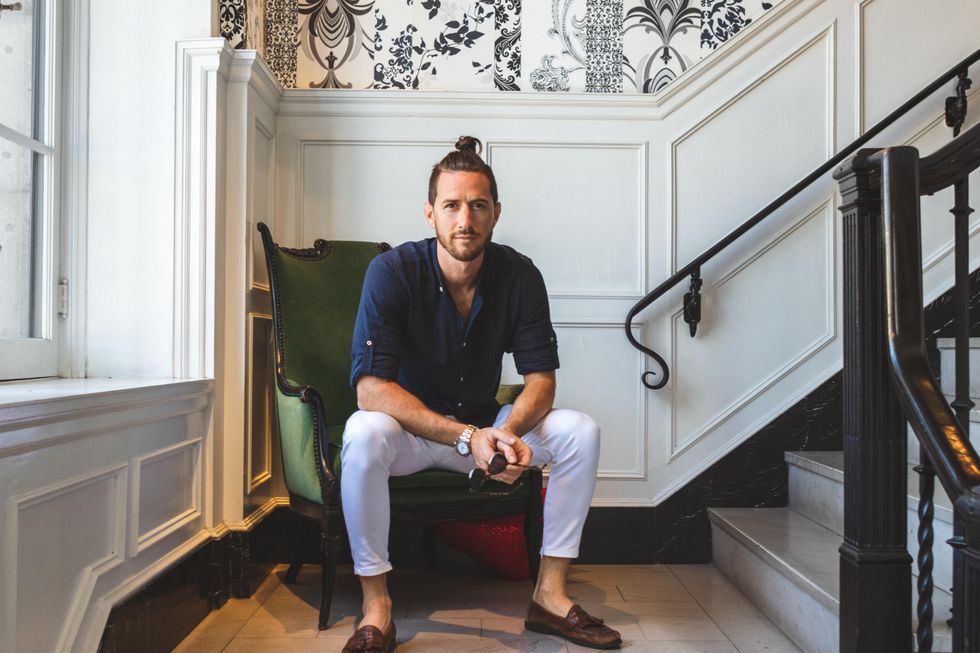Katy Johnson, a reality TV star and globe-trotting travel blogger, has lately offered some advice to her more than 100,000 Instagram followers.
“I urge you to learn a new language,” the model has told her fans, noting how locals in the foreign countries she has visited appreciate the effort. “It’s essential to be able to connect with people as much as possible while I travel,” she wrote in another post last month. Johnson, a former contestant on the TV show “Joe Millionaire,” has repeatedly suggested one particular way to study a new language: HeyPal, a one-year-old language-learning app.

A photo from Johnson's Instagram account, which she's used to promote HeyPal.
Photo courtesy of HeyPal
“Today I wanted to work on some Arabic slang, so I literally can pull out the phone and use the app anywhere, anytime!” read a caption to one photo of Johnson sitting near the Indian Ocean with a smartphone in her hands and a cocktail nearby.
At first glance, her casual endorsements may look like mere tips from a travel expert. But the Instagram posts, sprinkled between photos of the model posing in exotic tropical locations, are part of a paid campaign by HeyPal, which is owned by Beverly Hills-based digital app developer ClickStream.
HeyPal—which promises to help users learn new languages through social media posts and online chats with native speakers—has made content creators like Johnson a key part of its marketing and growth strategy. The app is currently paying three influencers, including Johnson, to spread the gospel by showcasing glamorous real-life examples of how people can benefit from the platform.
HeyPal, which has racked up more than 1 million downloads since going live last June, is hardly the only brand turning to influencers. Spending on influencer marketing has exploded in recent years, jumping from only $1.7 billion in 2016 to $16.4 billion this year, according to research from Influencer Marketing Hub.
In some ways, influencer marketing is not much different from traditional celebrity endorsements where actors, artists and athletes hawk products in advertisements. But online influencers often forge deep relationships with their fans, making their endorsements more effective, according to experts. That’s especially true if the products or services they’re marketing naturally fit with the content they’re creating—such as Johnson highlighting a language-learning app as a travel blogger.
“At the end of the day, influencer marketing works because the audience trusts the creator,” Brad Hoos, CEO of influencer marketing agency The Outloud Group, told dot.LA. Hoos noted that customers acquired through influencers tend to stick with brands longer than those lured by other campaigns.
Launched in 2020, HeyPal aims to help people learn new languages by conversing with native speakers through social media features like chats, posts, comments and media uploads. HeyPal offers both free and paid versions of the app; the latter is available in two subscription tiers ($9.99 or $14.99 per month) and includes additional features like unlimited translations on posts and a “PenPal” feature that matches users who can teach each other new languages.
HeyPal CEO Jonathan Maxim, a marketing veteran who ClickStream hired for the role last year, told dot.LA that Johnson and the app’s other influencers bring credibility to the platform. Those other influencers include Jessica Killings, an actress, model and angel investor who, like Johnson, has a large Instagram following.

HeyPal has worked with roughly 20 influencers to date, though it has only struck paid partnership deals with three, according to Maxim. (“The other 20 or so are just enthusiasts of the mission,” he noted.) The company declined to share how much it pays influencers to market its app.
In addition to boosting the brand’s visibility, HeyPal’s influencers are able to steer people to the app or channels like its Instagram account, through which the company can later retarget them with ads or push notifications, Maxim said. HeyPal can measure reach, click-through rates and number of app downloads by influencer, and can optimize its ads accordingly.
“Influencer marketing serves the top of the funnel for us,” Maxim said. “Katy creates engaging content, brings people to the middle of the funnel, and then we retarget them and bring them to the bottom of the funnel—which is conversion and engagement in the app.”
Johnson’s Instagram endorsements don’t dig into the details of the app, but they subtly suggest the perks of learning a new language. An Instagram Reels video she made in March shows Johnson dancing and posing for selfies with people around the world—activities presumably made possible by her ability to speak different languages.
“These types of posts help people dream—to see a country and the beauty, the food, the people,” said Jamie Gutfreund, chief marketing officer for Los Angeles-based Whalar, a creator economy company that works with influencers and brands. “They can imagine what their experience could be, especially if they have learned the language.”
Creators have to tread carefully when it comes to corporate partnerships, however. Although brand deals may provide more stable income than platform ad revenue, creators have to ensure they don’t harm their authenticity by constantly promoting products, experts said. About 13% of fans say they have unfollowed a creator because they included too many ads in their content, according to a recent survey.
Johnson is keenly aware of that balancing act: She said she sends just a few promotional posts per month and doesn’t endorse anything on Instagram “unless I really believe in it.” Asked how she makes her promotional posts seem authentic, Johnson said she doesn’t need to.
“I don't really make it look like anything—it is authentic,” she told dot.LA, pointing to videos she shared of her playing with children in Kenya or receiving some help putting on a hijab in Egypt.
“Those are all real moments that I've had,” she added. “And some of these moments can be helped when I'm learning language from language apps.”
- TikTok, Influencer Panic and the Celebrity Economy - dot.LA ›
- Los Angeles Influencer News - dot.LA ›
- Influencers and Influencer Trends to Watch in 2022 - dot.LA ›
- How Influencers Became Key to Big Brands During the Pandemic ... ›
- Why Creators Should Build Community Rather Than a Fan Base - dot.LA ›

